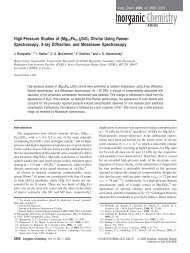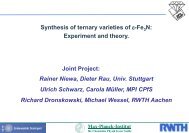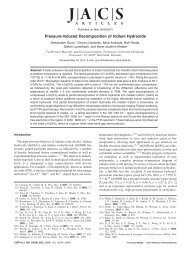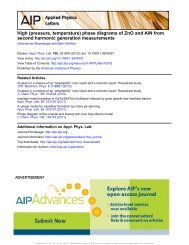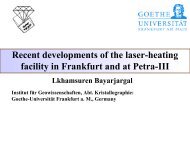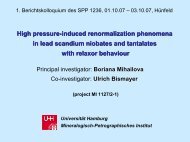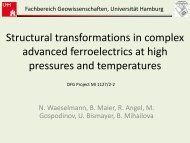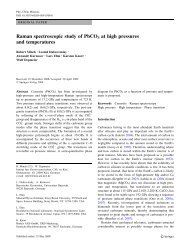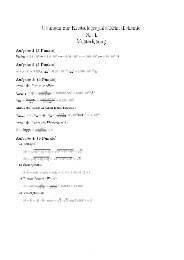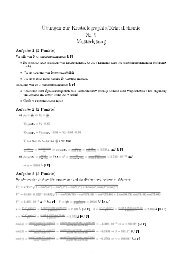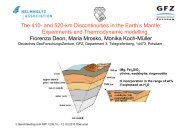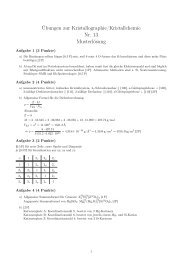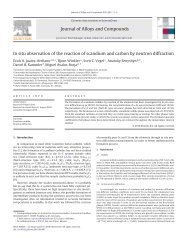Synthesis and properties of oxygen-bearing c-Zr3N4 and c-Hf3N4
Synthesis and properties of oxygen-bearing c-Zr3N4 and c-Hf3N4
Synthesis and properties of oxygen-bearing c-Zr3N4 and c-Hf3N4
Create successful ePaper yourself
Turn your PDF publications into a flip-book with our unique Google optimized e-Paper software.
Journal <strong>of</strong> Alloys <strong>and</strong> Compounds 480 (2009) 46–49<br />
Contents lists available at ScienceDirect<br />
Journal <strong>of</strong> Alloys <strong>and</strong> Compounds<br />
journal homepage: www.elsevier.com/locate/jallcom<br />
<strong>Synthesis</strong> <strong>and</strong> <strong>properties</strong> <strong>of</strong> <strong>oxygen</strong>-<strong>bearing</strong> c-<strong>Zr3N4</strong> <strong>and</strong> c-<strong>Hf3N4</strong><br />
D.A. Dzivenko a,∗ , A. Zerr b , G. Miehe a , R. Riedel a<br />
a FB Materialwissenschaft, TU Darmstadt, Petersenstr. 23, 64287 Darmstadt, Germany<br />
b LPMTM-CNRS, Université Paris Nord, 99 av. J.B. Clement, 93430 Villetaneuse, France<br />
article info<br />
Article history:<br />
Received 30 June 2008<br />
Received in revised form 2 October 2008<br />
Accepted 2 October 2008<br />
Available online 22 November 2008<br />
PACS:<br />
61.05.cp<br />
62.20.de<br />
62.20.Qp<br />
62.50.−p<br />
64<br />
64.30.−t<br />
65.40.De<br />
81.05.Je<br />
Keywords:<br />
Nitride materials<br />
Transition metal alloys <strong>and</strong> compounds<br />
Crystal structure<br />
Mechanical <strong>properties</strong><br />
High pressure<br />
1. Introduction<br />
abstract<br />
The group 4 transition metal mononitrides -MN (where M<br />
is Ti, Zr or Hf) having cubic NaCl-type structure are well known<br />
refractory materials with unique combinations <strong>of</strong> mechanical, thermal,<br />
chemical <strong>and</strong> electro-magnetic <strong>properties</strong>. They have found a<br />
broad industrial application as hard wear resistant coatings <strong>of</strong> cutting<br />
tools, corrosion <strong>and</strong> abrasion protection layers on mechanical<br />
<strong>and</strong> optical components, diffusion barriers <strong>and</strong> superconductors in<br />
microelectronics [1,2]. With respect to stoichiometric M 3N 4 compounds<br />
<strong>of</strong> the group 4 elements, only orthorhombic zirconium<br />
nitride, o-Zr 3N 4, was known for a long time [3–5].<br />
Here we review our work on synthesis, characterization <strong>and</strong><br />
investigation <strong>of</strong> <strong>properties</strong> <strong>of</strong> novel cubic Zr 3N 4 <strong>and</strong> Hf 3N 4. These<br />
nitrides were first obtained via chemical reactions <strong>of</strong> zirconium<br />
<strong>and</strong> hafnium or their mononitrides (-MN) with molecular nitro-<br />
∗ Corresponding author. Tel.: +49 6151 166341; fax: +49 6151 166346.<br />
E-mail address: dzivenko@materials.tu-darmstadt.de (D.A. Dzivenko).<br />
0925-8388/$ – see front matter © 2008 Elsevier B.V. All rights reserved.<br />
doi:10.1016/j.jallcom.2008.10.011<br />
This paper presents our recent results on synthesis <strong>and</strong> <strong>properties</strong> <strong>of</strong> high-pressure cubic zirconium(IV)<strong>and</strong><br />
hafnium(IV) nitrides having Th3P4-type structure, c-M3N4 (M = Zr or Hf). c-M3N4 were first synthesized<br />
in microscopic amounts in a laser-heated diamond anvil cell (LH-DAC) at pressures above<br />
15 GPa <strong>and</strong> temperatures above 2500 K. Further, macroscopic amounts <strong>of</strong> c-<strong>Hf3N4</strong> <strong>and</strong> <strong>of</strong> a new <strong>oxygen</strong><strong>bearing</strong><br />
zirconium nitride, c-Zr2.86(N0.88O0.12)4, were synthesized at 12 GPa <strong>and</strong> about 1900 K using a<br />
multi-anvil apparatus. The lattice parameter <strong>of</strong> c-<strong>Hf3N4</strong> was determined to be a0 = 670.2(1) pm. The a0<br />
<strong>of</strong> c-Zr2.86(N0.88O0.12)4 <strong>of</strong> 675.49(1) pm was found to be slightly larger than that <strong>of</strong> c-<strong>Zr3N4</strong> (674.0(6) pm).<br />
The bulk moduli, B0, <strong>of</strong> 219 GPa for c-Zr2.86(N0.88O0.12)4 <strong>and</strong> <strong>of</strong> 227 GPa for c-<strong>Hf3N4</strong> were obtained from<br />
compression measurements. Combining the compression <strong>and</strong> indentation data we determined for c-<br />
Zr2.86(N0.88O0.12)4 its isotropic shear modulus G0 = 96 GPa. Finally, Vickers microhardness, indentation<br />
fracture toughness <strong>and</strong> thermal expansion <strong>of</strong> c-Zr2.86(N0.88O0.12)4 were measured.<br />
© 2008 Elsevier B.V. All rights reserved.<br />
gen at high pressures (>15 GPa) <strong>and</strong> high temperatures (>2500 K)<br />
in a LH-DAC [6]. Examination <strong>of</strong> the structure <strong>and</strong> stoichiometry<br />
<strong>of</strong> the products using XRD <strong>and</strong> EDX revealed that the reaction<br />
products were stoichiometric nitrides <strong>Zr3N4</strong> <strong>and</strong> <strong>Hf3N4</strong> with cubic<br />
Th3P4-type structure (space group I ¯43d, No. 220) [6]. It should be<br />
pointed out that c-<strong>Zr3N4</strong> <strong>and</strong> c-<strong>Hf3N4</strong> are the first binary nitrides<br />
with eightfold coordinated cations [6]. Preliminary compressibility<br />
measurements have indicated high bulk moduli, B0, <strong>of</strong> about<br />
250 GPa (with B ′ = 4) for both compounds thus suggesting their<br />
0<br />
high hardness.<br />
Subsequent theoretical studies <strong>of</strong> these transition metal nitrides<br />
supported the structure assignment <strong>and</strong> a low compressibility <strong>of</strong> c-<br />
M3N4 [7–9]: The B0 values <strong>of</strong> 195–265 GPa <strong>and</strong> 215–283 GPa were<br />
predicted for c-<strong>Zr3N4</strong> <strong>and</strong> c-<strong>Hf3N4</strong>, respectively. Using these results<br />
<strong>and</strong> an empirical correlation between hardness <strong>and</strong> elastic moduli<br />
[10], Mattesini et al. [8] suggested the Vickers hardness value <strong>of</strong><br />
about 20 GPa for the both compounds. Further interest in these<br />
materials was excited by the finding that thin films <strong>of</strong> c-<strong>Zr3N4</strong> are significantly harder than those <strong>of</strong> -ZrN <strong>and</strong> dramatically outperform<br />
-TiN (by one order <strong>of</strong> magnitude) in wear resistance by
machining <strong>of</strong> low-carbon steels [11]. Titanium mononitride, in turn,<br />
is a well-known hard wear-resistant material which is traditionally<br />
used in mono- <strong>and</strong> multilayer coatings <strong>of</strong> cutting <strong>and</strong> milling<br />
tools because it considerably increases their service life [12,13]. The<br />
films <strong>of</strong> pure c-Zr 3N 4 were prepared via the technique <strong>of</strong> physical<br />
vapour deposition (PVD) by applying a modified filtered cathodic<br />
arc method [11]. The authors were able to control the stoichiometry<br />
<strong>and</strong> the structure <strong>of</strong> the nitrides <strong>and</strong> to deposit stoichiometric -ZrN<br />
or Zr 3N 4 with either orthorhombic or cubic structure. These results<br />
demonstrated a great potential <strong>of</strong> c-M 3N 4 for industrial application<br />
as hard wear-resistant coatings.<br />
Very recently we succeeded in synthesis <strong>of</strong> macroscopic<br />
amounts (>1 mm 3 ) <strong>of</strong> <strong>oxygen</strong>-<strong>bearing</strong> cubic zirconium(IV) nitride,<br />
c-Zr 2.86(N 0.88O 0.12) 4 [14], as well as <strong>of</strong> c-Hf 3N 4 at high pressures<br />
<strong>and</strong> temperatures. The obtained materials were examined using the<br />
XRD-, TEM-, EPMA- <strong>and</strong> SEM-techniques. The results are described<br />
below. We also present accurate values for B 0 <strong>of</strong> c-Zr 2.86(N 0.88O 0.12) 4<br />
<strong>and</strong> c-Hf 3N 4 derived from their equations <strong>of</strong> state (EOS), V(P),<br />
measured on compression at RT [15,16]. Applying nanoindentation<br />
technique we obtained the reduced elastic modulus, Er, <strong>and</strong><br />
hardness, H, <strong>of</strong> c-Zr 2.86(N 0.88O 0.12) 4. Combining the results for B 0<br />
<strong>and</strong> Er we derived the shear modulus, G 0, for c-Zr 2.86(N 0.88O 0.12) 4<br />
[15]. Hardness <strong>and</strong> fracture toughness <strong>of</strong> porous <strong>oxygen</strong>-<strong>bearing</strong> c-<br />
Zr 3N 4 were determined from Vickers indentation testing. Finally,<br />
the first results on thermal expansion <strong>of</strong> c-Zr 2.86(N 0.88O 0.12) 4 from<br />
high-temperature XRD measurements will be described.<br />
2. Experimental methods<br />
The high-pressure high-temperature synthesis <strong>of</strong> macroscopic amounts <strong>of</strong><br />
<strong>oxygen</strong>-<strong>bearing</strong> c-<strong>Zr3N4</strong> <strong>and</strong> <strong>of</strong> c-<strong>Hf3N4</strong> was performed in a multi-anvil apparatus.<br />
As a starting material we used nanocrystalline powders <strong>of</strong> nitrogen-rich zirconium<br />
<strong>and</strong> hafnium nitrides (N:M > 1.33) having distorted NaCl-type structure [17]. The<br />
starting materials in platinum capsules were compressed to 12 GPa <strong>and</strong> heated<br />
up to 1900 K, kept at the maximum temperature for about 20 min <strong>and</strong> quenched.<br />
The recovered products were characterized using an electron probe micro-analyzer<br />
CAMECA SX-50, a scanning electron microscope Philips XL30 FEG <strong>and</strong> a TEM Philips<br />
CM20 equipped with an EDX-detector. The powder X-ray diffractograms <strong>of</strong> highpressure<br />
nitrides were collected using a STOE STADI P diffractometer with Mo-K1<br />
radiation.<br />
The EOS <strong>of</strong> c-Zr2.86(N0.88O0.12)4 <strong>and</strong> c-<strong>Hf3N4</strong>, synthesized in a multi-anvil apparatus<br />
[14] <strong>and</strong> in a LH-DAC [6], respectively, were measured on compression at RT<br />
in a DAC to about 45 GPa. Argon was used as quasi-hydrostatic pressure medium.<br />
Pressure values were determined from the EOS <strong>of</strong> crystalline argon [18]. Specific<br />
volumes <strong>of</strong> the sample material <strong>and</strong> <strong>of</strong> argon at high pressures were derived from<br />
the EDX powder diffraction patterns measured using a polychromatic synchrotron<br />
radiation (beam-line F3 at the HasyLab, DESY, Hamburg, Germany).<br />
Nanoindentation testing was carried out on a polished surface <strong>of</strong> the porous<br />
polycrystalline c-Zr2.86(N0.88O0.12)4 using Nanoindenter XP equipped with the continuous<br />
stiffness measurement (CSM) module [19]. Experiments were performed<br />
to two maximum loads <strong>of</strong> about 23 mN <strong>and</strong> 14 mN which corresponded to maximal<br />
indentation depths <strong>of</strong> about 260 nm <strong>and</strong> 210 nm, respectively. In the Vickers<br />
hardness measurements the loads between 0.49 N <strong>and</strong> 9.8 N were applied. Thermal<br />
expansion <strong>of</strong> c-Zr2.86(N0.88O0.12)4 was examined to 873 K using a STOE STADI P X-ray<br />
diffractometer equipped with a curved imaging plate position sensitive detector.<br />
3. Results <strong>and</strong> discussion<br />
The XRD examination <strong>of</strong> the zirconium nitride product synthesized<br />
in a multi-anvil apparatus showed only lines <strong>of</strong> a cubic<br />
phase having Th 3P 4-type structure (Fig. 1). The EPMA revealed<br />
presence <strong>of</strong> a minor amount <strong>of</strong> <strong>oxygen</strong> (mass fraction <strong>of</strong> 0.024).<br />
Since in the TEM investigations no amorphous oxidic layers were<br />
observed on the grain surfaces, we concluded that <strong>oxygen</strong> was<br />
incorporated in the crystal structure <strong>and</strong> the composition <strong>of</strong> the<br />
product could be expressed as Zr 2.86(N 0.88O 0.12) 4. This suggested<br />
formation <strong>of</strong> an <strong>oxygen</strong>-<strong>bearing</strong> cubic zirconium(IV) nitride <strong>of</strong> the<br />
general composition Zr 3−u(N 1−uOu) 4. Here, formation <strong>of</strong> vacancies<br />
at the cation sites required by the condition <strong>of</strong> electrical neutrality<br />
is taken into account. This supposition was verified by a<br />
D.A. Dzivenko et al. / Journal <strong>of</strong> Alloys <strong>and</strong> Compounds 480 (2009) 46–49 47<br />
Fig. 1. Powder XRD patterns <strong>of</strong> c-Zr2.86(N0.88O0.12)4 (top) <strong>and</strong> c-<strong>Hf3N4</strong> (bottom) synthesized<br />
at 12 GPa <strong>and</strong> 1900 K in a multi-anvil apparatus. The Bragg positions <strong>of</strong> the<br />
Th3P4-type phases are displayed below the patterns. The asterisks denote the XRD<br />
reflexes from an oxidic impurity in the hafnium nitride sample.<br />
full-pr<strong>of</strong>ile Rietveld structure refinement <strong>of</strong> the XRD data (Fig. 1)<br />
[14]. The lattice parameter <strong>of</strong> c-Zr2.86(N0.88O0.12) 4 was found to<br />
be a0 = 675.49(1) pm which is slightly larger than a0 = 674.0(6) pm<br />
reported earlier for c-<strong>Zr3N4</strong> [6]. This observation contradicts to<br />
an expected decrease <strong>of</strong> a0 due to both substitution <strong>of</strong> N3− by<br />
O2− anions having smaller ionic radius <strong>and</strong> formation <strong>of</strong> cation<br />
vacancies. However, recent theoretical calculations have shown<br />
that incorporation <strong>of</strong> <strong>oxygen</strong> in c-M3N4 (M = Zr or Hf) results in<br />
a weakening <strong>of</strong> the cation-anion bonding [20]. This leads to reduction<br />
<strong>of</strong> elastic moduli <strong>of</strong> <strong>oxygen</strong>-<strong>bearing</strong> c-M3N4 <strong>and</strong>, on reaching<br />
<strong>of</strong> a critical <strong>oxygen</strong> concentration, to expansion <strong>of</strong> the unit cell [20].<br />
The formation <strong>of</strong> cation vacancies, however, was not considered in<br />
the calculations.<br />
The EPMA detected a minor amount <strong>of</strong> <strong>oxygen</strong> (mass fraction <strong>of</strong><br />
∼0.02) in hafnium nitride sample as well. However, in contrast to<br />
<strong>oxygen</strong>-<strong>bearing</strong> c-<strong>Zr3N4</strong>, results <strong>of</strong> XRD-, SEM- <strong>and</strong> EDX-analyses<br />
revealed the presence <strong>of</strong> a crystalline hafnium oxide or oxynitride,<br />
in addition to c-<strong>Hf3N4</strong>. The nature <strong>of</strong> the contaminating oxidic<br />
phase could not be determined unambiguously due to a low intensity<br />
<strong>of</strong> its XRD reflexes (Fig. 1). The lattice parameter <strong>of</strong> c-<strong>Hf3N4</strong> <strong>of</strong><br />
a0 = 670.2(1) pm was found to be in agreement with that reported<br />
earlier (a0 = 670.1(6) pm) [6]. Ifa0 <strong>of</strong> c-M3N4 is influenced by substitution<br />
<strong>of</strong> nitrogen by <strong>oxygen</strong> [20], it should be recognized that, in<br />
contrast to zirconium, cubic hafnium(IV) nitride precludes <strong>oxygen</strong><br />
incorporation in the structure. Influence <strong>of</strong> <strong>oxygen</strong> impurities on<br />
the lattice parameter <strong>and</strong> <strong>properties</strong> <strong>of</strong> c-M3N4 could be a subject<br />
<strong>of</strong> future experimental <strong>and</strong> theoretical work.<br />
The V(P) dependences <strong>of</strong> c-Zr2.86(N0.88O0.12) 4 <strong>and</strong> c-<strong>Hf3N4</strong> measured<br />
at RT in a DAC to about 45 GPa [15,16] are shown in Fig. 2.<br />
From the least-square fit <strong>of</strong> the Birch-Murnaghan EOS [21] to the<br />
experimental data we obtained B0 = 219(13) GPa, B ′ = 4.4(10) <strong>and</strong><br />
0
48 D.A. Dzivenko et al. / Journal <strong>of</strong> Alloys <strong>and</strong> Compounds 480 (2009) 46–49<br />
B0 = 227(7) GPa, B ′<br />
0 = 5.3(6) for c-Zr2.86(N0.88O0.12) 4 <strong>and</strong> c-<strong>Hf3N4</strong>, respectively. For B ′<br />
0 fixed at 4 we obtained B0 = 224(5) GPa for<br />
c-Zr2.86(N0.88O0.12) 4 <strong>and</strong> 241(2) GPa for c-<strong>Hf3N4</strong>. The theoretical<br />
predictions for B0 <strong>of</strong> c-M3N4 [7–9] scatter around our experimental<br />
values.<br />
SEM investigations have shown that our samples were highly<br />
porous with pore sizes <strong>of</strong> 0.05–2 m. The average volume fraction<br />
porosity (VFP) was estimated to be about 0.25–0.3 for both<br />
zirconium- <strong>and</strong> hafnium-nitride products. Nanoindentation measurements<br />
on a polished surface <strong>of</strong> the porous c-Zr2.86(N0.88O0.12) 4<br />
gave Er = 231 GPa <strong>and</strong> H = 18(2) GPa [15]. Using the experimental<br />
values for B0 <strong>and</strong> Er <strong>and</strong> the well-known relations between isotropic<br />
Er, E, B, G, <strong>and</strong> [22] we determined for c-Zr2.86(N0.88O0.12) 4<br />
G0 =96GPa<strong>and</strong>E0 = 252 GPa [15]. The obtained values should be<br />
considered as the lower limits since they could be altered by porosity.<br />
We were also able to perform reliable Vickers microhardness<br />
measurements for our porous c-Zr2.86(N0.88O0.12) 4 <strong>and</strong> obtained<br />
HV(1) = 12.0(6) GPa [14]. This value is similar to HV(1) <strong>of</strong> single crystal<br />
-ZrN (12.2 GPa) [23] but about 2.5 times higher than that for<br />
porous polycrystalline -ZrN with the VFP <strong>of</strong> ∼0.18 [24]. Based on<br />
the known hardness-porosity relations for hard ceramic materials<br />
[24,25], we estimated the HV value <strong>of</strong> fully dense c-<strong>Zr3N4</strong> to exceed<br />
30 GPa.<br />
For high indentation loads (≥2.94 N) our SEM investigations<br />
revealed presence <strong>of</strong> radial cracks having their origin at the corners<br />
<strong>of</strong> the Vickers impressions. The crack lengths were used<br />
for estimation <strong>of</strong> the indentation fracture toughness, KIc-if, <strong>of</strong>c-<br />
Zr2.86(N0.88O0.12) 4 according to the equations <strong>of</strong> Niihara et al. [26]<br />
<strong>and</strong> Shetty et al. [27]. The average value <strong>of</strong> KIc-if was derived to<br />
be 3.2(3) MPa m1/2 which is slightly lower than KIc-if reported for<br />
hot-isostatically pressed -MN [28–30]. As above for other elastomechanical<br />
values, the present KIc-if is considered as the lower limit<br />
for dense c-<strong>Zr3N4</strong>. In order to obtain the thermal expansion coefficient <strong>of</strong><br />
c-Zr2.86(N0.88O0.12) 4, its XRD powder patterns were collected<br />
on heating in air to 873 K. The observed nonlinear temperature<br />
dependence <strong>of</strong> the lattice parameter <strong>of</strong> c-Zr2.86(N0.88O0.12) 4<br />
(Fig. 3) was fitted with a third order polynomial function:<br />
a(T) = 674.6 + 8.422 × 10−6 T2 − 2.205 × 10−9 T3 [pm]. This dependence<br />
fulfils the boundary condition for the thermal expansion<br />
coefficient (lim ˛(T)=0 forT→ 0) <strong>and</strong> the tendency <strong>of</strong> ˛(T) toa<br />
Fig. 2. Pressure dependences <strong>of</strong> V/V0 <strong>of</strong> c-Zr2.86(N0.88O0.12)4 (open circles) <strong>and</strong><br />
c-<strong>Hf3N4</strong> (solid squares) measured at RT. Solid lines represent the least-squares<br />
fit <strong>of</strong> the third-order Birch-Murnaghan EOS to the experimental data. The<br />
fits yielded B0 = 219(13) GPa, B ′ = 4.4(10) <strong>and</strong> B0 = 227(7) GPa, B′ = 5.3(6) for c-<br />
0 0<br />
Zr2.86(N0.88O0.12)4 <strong>and</strong> c-<strong>Hf3N4</strong>, respectively.<br />
Fig. 3. Thermal expansion data for c-Zr2.86(N0.88O0.12)4: Lattice parameter, a(T), measured<br />
at elevated temperatures (solid circles) <strong>and</strong> fitted by a third order polynomial<br />
function (solid line). Linear thermal expansion coefficient, ˛, as a function <strong>of</strong> temperature<br />
(dashed line).<br />
constant value at high temperatures [31]. Applying this result we<br />
derived the linear thermal expansion coefficient ˛(T) defined as<br />
˛(T)=(∂a(T)/∂T)/a(T) (Fig. 3). It can be seen from Fig. 3 that ˛(T)<br />
increases from 6.6 × 10 −6 K −1 to 14.2 × 10 −6 K −1 in the investigated<br />
temperature region <strong>and</strong> is about twice as large as those <strong>of</strong> -<br />
ZrN [32–34] <strong>and</strong> o-Zr 3N 4 [5] at 900 K. Such a high ˛(T) value <strong>of</strong><br />
c-Zr 2.86(N 0.88O 0.12) 4 can be explained by a less symmetric interatomic<br />
potential in c-Zr 3N 4 due to higher atomic coordinations<br />
when compared with -ZrN <strong>and</strong> o-Zr 3N 4. It should be also mentioned<br />
that, similar to o-Zr 3N 4 <strong>and</strong> zirconium oxynitrides [35],<br />
c-Zr 2.86(N 0.88O 0.12) 4 starts to oxidise in air above 773 K. The main<br />
oxidation product was found to be -Zr 2ON 2 [36] which further<br />
oxidises to monoclinic ZrO 2.<br />
Acknowledgements<br />
We acknowledge financial supports <strong>of</strong> the Deutsche Forschungsgemeinschaft<br />
(Bonn, Germany), the Fonds der Chemischen<br />
Industrie (Frankfurt, Germany), the Adolf-Messer-Foundation (Germany)<br />
<strong>and</strong> DESY (Hamburg, Germany). We also thank the HasyLab<br />
(at DESY) for technical support. We are grateful to V.K. Bulatov, H.<br />
Steinberg <strong>and</strong> G. Brey for multi-anvil experiments, to B. Thybusch<br />
for EPMA measurements <strong>and</strong> to E. Schweitzer <strong>and</strong> M. Göken for<br />
nanoindentation measurements.<br />
References<br />
[1] L.E. Toth, Transition Metal Carbides <strong>and</strong> Nitrides, Academic Press, New York,<br />
1971.<br />
[2] W. Lengauer, in: R. Riedel (Ed.), H<strong>and</strong>book <strong>of</strong> Ceramic Hard Materials, WILEY-<br />
VCH, Weinheim, 2000, pp. 202–252.<br />
[3] A. Yajima, Y. Segawa, R. Matsuzaki, Y. Saeki, Bull. Chem. Soc. Jpn. 56 (1983)<br />
2638–2642.<br />
[4] R. Juza, A. Rabenau, I. Nitschke, Z. Anorg. Allg. Chem. 332 (1964) 1–4.<br />
[5] M. Lerch, E. Füglein, J. Wrba, Z. Anorg. Allg. Chem. 622 (1996) 367–372.<br />
[6] A. Zerr, G. Miehe, R. Riedel, Nat. Mater. 2 (2003) 185–189.<br />
[7] P. Kroll, Phys. Rev. Lett. 90 (2003) 125501.<br />
[8] M. Mattesini, R. Ahuja, B. Johansson, Phys. Rev. B 68 (2003) 184108.<br />
[9] J.E. Lowther, Physica B 358 (2005) 72–76.<br />
[10] D.M. Teter, MRS Bull. 23 (1998) 22–27.<br />
[11] M. Chhowalla, H.E. Unalan, Nat. Mater. 4 (2005) 317–322.<br />
[12] Y.L. Su, W.H. Kao, Wear 223 (1998) 119–130.<br />
[13] P. Ettmayer, W. Lengauer, Ullmann’s Encyclopedia <strong>of</strong> Industrial Chemistry,<br />
Wiley-VCH, Weinheim, 1991, pp. 341.<br />
[14] D.A. Dzivenko, A. Zerr, V.K. Bulatov, G. Miehe, J.W. Li, B. Thybusch, J. Brötz, H.<br />
Fuess, G. Brey, R. Riedel, Adv. Mater. 19 (2007) 1869–1873.<br />
[15] D.A. Dzivenko, A. Zerr, E. Schweitzer, M. Göken, R. Boehler, R. Riedel, Appl. Phys.<br />
Lett. 90 (2007) 191910.
[16] D.A. Dzivenko, A. Zerr, R. Boehler, R. Riedel, Solid State Commun. 139 (2006)<br />
255–258.<br />
[17] J.W. Li, D.A. Dzivenko, A. Zerr, C. Fasel, Y.P. Zhou, R. Riedel, Z. Anorg. Allg. Chem.<br />
631 (2005) 1449–1455.<br />
[18] P. Richet, J.A. Xu, H.K. Mao, Phys. Chem. Miner. 16 (1988) 207–211.<br />
[19] W.C. Oliver, G.M. Pharr, J. Mater. Res. 7 (1992) 1564–1583.<br />
[20] J.E. Lowther, Solid State Commun. (2008), doi:10.1016/j.ssc.2008.1009.1046.<br />
[21] F. Birch, J. Geophys. Res. 83 (1978) 1257–1268.<br />
[22] L.D. L<strong>and</strong>au, E.M. Lifshitz, Course <strong>of</strong> Theoretical Physics, vol. 7: Theory <strong>of</strong> Elasticity,<br />
vol. 7, Pergamon Press, London, 1975.<br />
[23] X.J. Chen, V.V. Struzhkin, Z.G. Wu, M. Somayazulu, J. Qian, S. Kung, A.N. Christensen,<br />
Y.S. Zhao, R.E. Cohen, H.K. Mao, R.J. Hemley, Proc. Natl. Acad. Sci. U.S.A.<br />
102 (2005) 3198–3201.<br />
[24] J. Adachi, K. Kurosaki, M. Uno, S. Yamanaka, J. Nucl. Mater. 358 (2006) 106–110.<br />
[25] J. Luo, R. Stevens, Ceram. Int. 25 (1999) 281–286.<br />
[26] K. Niihara, R. Morena, D.P.H. Hasselman, J. Mater. Sci. Lett. 1 (1982) 13–16.<br />
[27] D.K. Shetty, I.G. Wright, P.N. Mincer, A.H. Clauer, J. Mater. Sci. 20 (1985)<br />
1873–1882.<br />
D.A. Dzivenko et al. / Journal <strong>of</strong> Alloys <strong>and</strong> Compounds 480 (2009) 46–49 49<br />
[28] N. Alex<strong>and</strong>re, M. Desmaisonbrut, F. Valin, M. Boncoeur, J. Mater. Sci. 28 (1993)<br />
2385–2390.<br />
[29] M. Desmaison-Brut, J. Montintin, F. Valin, M. Boncoeur, J. Eur. Ceram. Soc. 13<br />
(1994) 379–386.<br />
[30] M. Moriyama, H. Aoki, Y. Kobayashi, K. Kamata, J. Ceram. Soc. Jpn. 101 (1993)<br />
279–284.<br />
[31] H.T. Hintzen, M. Hendrix, H. Wondergem, C.M. Fang, T. Sekine, G. de With, J.<br />
Alloys Compd. 351 (2003) 40–42.<br />
[32] M. Takano, S. Tagami, K. Minato, T. Kozaki, S. Sato, J. Alloys Compd. 439 (2007)<br />
215–220.<br />
[33] T.W. Baker, Acta Cryst. 11 (1958) 300–1300.<br />
[34] K. Aigner, W. Lengauer, D. Rafaja, P. Ettmayer, J. Alloys Compd. 215 (1994)<br />
121–126.<br />
[35] M. Lerch, Fakultät für Chemie und Pharmazie, Bayerische Julius-Maximilians-<br />
Universität, Würzburg, 1997.<br />
[36] S.J. Clarke, C.W. Michie, M.J. Rosseinsky, J. Solid State Chem. 146 (1999) 399–<br />
405.



